Legacy Dichlorodiphenyltrichloroethane (DDT) Pollution in a River Ecosystem: Sediment Contamination and Bioaccumulation in Benthic Invertebrates
Abstract
1. Introduction
2. Materials and Methods
2.1. Study Area
2.2. Sampling Sites
2.3. Sediment and Benthic Invertebrates Sampling
2.4. Chemical Analyses
2.5. Data Analysis
3. Results and Discussion
3.1. DDx in Sediments
3.2. DDx Bioaccumulation in Benthic Invertebrates
3.3. Relations between DDx Bioaccumulation in Benthic Invertebrates and Sediment Concentrations
4. Conclusions
Supplementary Materials
Author Contributions
Funding
Institutional Review Board Statement
Informed Consent Statement
Data Availability Statement
Acknowledgments
Conflicts of Interest
References
- Jaga, K.; Dharmani, C. Global Surveillance of DDT and DDE Levels in Human Tissues. Int. J. Occup. Med. Environ. Health 2003, 16, 7–20. [Google Scholar] [PubMed]
- Blanton, F.S. The Control of Epidemic Typhus. J. N. Y. Entomol. Soc. 1952, 60, 153–156. [Google Scholar]
- Li, Y.F.; Zhulidov, A.V.; Robarts, R.D.; Korotova, L.G.; Zhulidov, D.A.; Gurtovaya, T.Y.; Ge, L.P. Dichlorodiphenyltrichloroethane Usage in the Former Soviet Union. Sci. Total Environ. 2006, 357, 138–145. [Google Scholar] [CrossRef] [PubMed]
- Omlin, F.X.; Carlson, J.C.; Ogbunugafor, C.B.; Hassanali, A. Anopheles Gambiae Exploits the Treehole Ecosystem in Western Kenya: A New Urban Malaria Risk? American Society of Tropical Medicine and Hygiene: Arlington, VA, USA, 2007. [Google Scholar]
- Beard, J. DDT and Human Health. Sci. Total Environ. 2006, 355, 78–89. [Google Scholar] [CrossRef]
- Jongbloed, R.H.; Traas, T.P.; Luttik, R. A Probabilistic Model for Deriving Soil Quality Criteria Based on Secondary Poisoning of Top Predators: II. Calculations for Dichlorodiphenyltrichloroethane (DDT) and Cadmium. Ecotoxicol. Environ. Saf. 1996, 34, 279–306. [Google Scholar] [CrossRef] [PubMed]
- Nendza, M.; Herbst, T.; Kussatz, C.; Gies, A. Potential for Secondary Poisoning and Biomagnification in Marine Organisms. Chemosphere 1997, 35, 1875–1885. [Google Scholar] [CrossRef]
- Holm, L.; Blomqvist, A.; Brandt, I.; Brunström, B.; Ridderstråle, Y.; Berg, C. Embryonic Exposure to o,P′-DDT Causes Eggshell Thinning and Altered Shell Gland Carbonic Anhydrase Expression in the Domestic Hen. Environ. Toxicol. Chem. 2006, 25, 2787–2793. [Google Scholar] [CrossRef] [PubMed]
- Ivanova, A.; Wiberg, K.; Ahrens, L.; Zubcov, E.; Dahlberg, A.-K. Spatial Distribution of Legacy Pesticides in River Sediment from the Republic of Moldova. Chemosphere 2021, 279, 130923. [Google Scholar] [CrossRef] [PubMed]
- Karickhoff, S.W.; Brown, D.S.; Scott, T.A. Sorption of Hydrophobic Pollutants on Natural Sediments. Water Res. 1979, 13, 241–248. [Google Scholar] [CrossRef]
- Liber, Y.; Mourier, B.; Marchand, P.; Bichon, E.; Perrodin, Y.; Bedell, J.-P. Past and Recent State of Sediment Contamination by Persistent Organic Pollutants (POPs) in the Rhône River: Overview of Ecotoxicological Implications. Sci. Total Environ. 2019, 646, 1037–1046. [Google Scholar] [CrossRef]
- Zoumis, T.; Schmidt, A.; Grigorova, L.; Calmano, W. Contaminants in Sediments: Remobilisation and Demobilisation. Sci. Total Environ. 2001, 266, 195–202. [Google Scholar] [CrossRef] [PubMed]
- Nfon, E.; Cousins, I.T.; Broman, D. Biomagnification of Organic Pollutants in Benthic and Pelagic Marine Food Chains from the Baltic Sea. Sci. Total Environ. 2008, 397, 190–204. [Google Scholar] [CrossRef] [PubMed]
- Binelli, A.; Provini, A. DDT Is Still a Problem in Developed Countries: The Heavy Pollution of Lake Maggiore. Chemosphere 2003, 52, 717–723. [Google Scholar] [CrossRef] [PubMed]
- Bettinetti, R.; Croce, V.; Galassi, S. Ecological Risk Assessment for the Recent Case of DDT Pollution in Lake Maggiore (Northern Italy). Water Air Soil Pollut. 2005, 162, 385–399. [Google Scholar] [CrossRef]
- Pisanello, F.; Marziali, L.; Rosignoli, F.; Poma, G.; Roscioli, C.; Pozzoni, F.; Guzzella, L. In Situ Bioavailability of DDT and Hg in Sediments of the Toce River (Lake Maggiore Basin, Northern Italy): Accumulation in Benthic Invertebrates and Passive Samplers. Environ. Sci. Pollut. Res. 2016, 23, 10542–10555. [Google Scholar] [CrossRef] [PubMed]
- Marziali, L.; Rosignoli, F.; Drago, A.; Pascariello, S.; Valsecchi, L.; Rossaro, B.; Guzzella, L. Toxicity Risk Assessment of Mercury, DDT and Arsenic Legacy Pollution in Sediments: A Triad Approach under Low Concentration Conditions. Sci. Total Environ. 2017, 593–594, 809–821. [Google Scholar] [CrossRef]
- MacDonald, D.D.; Ingersoll, C.G.; Berger, T.A. Development and Evaluation of Consensus-Based Sediment Quality Guidelines for Freshwater Ecosystems. Arch. Environ. Contam. Toxicol. 2000, 39, 20–31. [Google Scholar] [CrossRef]
- Xu, Y.; Spurlock, F.; Wang, Z.; Gan, J. Comparison of Five Methods for Measuring Sediment Toxicity of Hydrophobic Contaminants. Environ. Sci. Technol. 2007, 41, 8394–8399. [Google Scholar] [CrossRef] [PubMed]
- Maruya, K.A.; Lao, W.; Tsukada, D.; Diehl, D.W. A Passive Sampler Based on Solid Phase Microextraction (SPME) for Sediment-Associated Organic Pollutants: Comparing Freely-Dissolved Concentration with Bioaccumulation. Chemosphere 2015, 137, 192–197. [Google Scholar] [CrossRef] [PubMed]
- Windsor, F.M.; Pereira, M.G.; Tyler, C.R.; Ormerod, S.J. River Organisms as Indicators of the Distribution and Sources of Persistent Organic Pollutants in Contrasting Catchments. Environ. Pollut. 2019, 255, 113144. [Google Scholar] [CrossRef]
- Verhaert, V.; Newmark, N.; D’Hollander, W.; Covaci, A.; Vlok, W.; Wepener, V.; Addo-Bediako, A.; Jooste, A.; Teuchies, J.; Blust, R.; et al. Persistent Organic Pollutants in the Olifants River Basin, South Africa: Bioaccumulation and Trophic Transfer through a Subtropical Aquatic Food Web. Sci. Total Environ. 2017, 586, 792–806. [Google Scholar] [CrossRef]
- Govaerts, A.; Verhaert, V.; Covaci, A.; Jaspers, V.L.; Berg, O.K.; Addo-Bediako, A.; Jooste, A.; Bervoets, L. Distribution and Bioaccumulation of POPs and Mercury in the Ga-Selati River (South Africa) and the Rivers Gudbrandsdalslågen and Rena (Norway). Environ. Int. 2018, 121, 1319–1330. [Google Scholar] [CrossRef] [PubMed]
- Wong, C.S.; Capel, P.D.; Nowell, L.H. National-Scale, Field-Based Evaluation of the Biota−Sediment Accumulation Factor Model. Environ. Sci. Technol. 2001, 35, 1709–1715. [Google Scholar] [CrossRef] [PubMed]
- de la Cal, A.; Eljarrat, E.; Raldúa, D.; Durán, C.; Barceló, D. Spatial Variation of DDT and Its Metabolites in Fish and Sediment from Cinca River, a Tributary of Ebro River (Spain). Chemosphere 2008, 70, 1182–1189. [Google Scholar] [CrossRef]
- Tomza-Marciniak, A.; Witczak, A. Bioaccumulation of DDT and Its Metabolites in the Międzyodrze Ecosystem, Poland. Pol. J. Environ. Stud. 2009, 18, 467–474. [Google Scholar]
- Choi, J.Y.; Yang, D.B.; Hong, G.H.; Shin, K.H. Distribution and Bioaccumulation of Polychlorinated Biphenyls and Organochlorine Pesticides Residues in Sediments and Manila Clams (Ruditapes Philippinarum) from along the Mid-Western Coast of Korea. Mar. Pollut. Bull. 2014, 85, 672–678. [Google Scholar] [CrossRef] [PubMed]
- Marziali, L.; Guzzella, L.; Salerno, F.; Marchetto, A.; Valsecchi, L.; Tasselli, S.; Roscioli, C.; Schiavon, A. Twenty-Year Sediment Contamination Trends in Some Tributaries of Lake Maggiore (Northern Italy): Relation with Anthropogenic Factors. Environ. Sci. Pollut. Res. 2021, 28, 38193–38208. [Google Scholar] [CrossRef] [PubMed]
- Ceschi, M.; De Rossa, M.; Jäggli, M. Contaminanti Organici, Inorganici e Radionuclidi Nell’ittiofauna Dei Laghi Ceresio e Verbano (Bacini Svizzeri). Mitt. Geb. Lebensm. Hyg. 1996, 87, 189–211. [Google Scholar]
- Ravazzani, G.; Dalla Valle, F.; Gaudard, L.; Mendlik, T.; Gobiet, A.; Mancini, M. Assessing Climate Impacts on Hydropower Production: The Case of the Toce River Basin. Climate 2016, 4, 16. [Google Scholar] [CrossRef]
- Marziali, L.; Roscioli, C.; Valsecchi, L. Mercury Bioaccumulation in Benthic Invertebrates: From Riverine Sediments to Higher Trophic Levels. Toxics 2021, 9, 197. [Google Scholar] [CrossRef] [PubMed]
- Gerner, N.V.; Koné, M.; Ross, M.S.; Pereira, A.; Ulrich, A.C.; Martin, J.W.; Liess, M. Stream Invertebrate Community Structure at Canadian Oil Sands Development Is Linked to Concentration of Bitumen-Derived Contaminants. Sci. Total Environ. 2017, 575, 1005–1013. [Google Scholar] [CrossRef] [PubMed]
- Schumacher, B.A. Methods for the Determination of Total Organic Carbon (TOC) in Soils and Sediments; U.S. Environmental Protection Agency: Washington, DC, USA, 2002. Available online: https://cfpub.epa.gov/si/si_public_record_report.cfm?Lab=NERL&dirEntryId=63371 (accessed on 17 March 2023).
- Pérez-Maldonado, I.N.; Trejo, A.; Ruepert, C.; del Carmen Jovel, R.; Méndez, M.P.; Ferrari, M.; Saballos-Sobalvarro, E.; Alexander, C.; Yáñez-Estrada, L.; Lopez, D.; et al. Assessment of DDT Levels in Selected Environmental Media and Biological Samples from Mexico and Central America. Chemosphere 2010, 78, 1244–1249. [Google Scholar] [CrossRef] [PubMed]
- Sudaryanto, A.; Isobe, T.; Takahashi, S.; Tanabe, S. Assessment of Persistent Organic Pollutants in Sediments from Lower Mekong River Basin. Chemosphere 2011, 82, 679–686. [Google Scholar] [CrossRef]
- Hitch, R.K.; Day, H.R. Unusual Persistence of DDT in Some Western USA Soils. Bull. Environ. Contam. Toxicol. 1992, 48, 259–264. [Google Scholar] [CrossRef] [PubMed]
- Burkhard, L. Estimation of Biota Sediment Accumulation Factor (BSAF) from Paired Observations of Chemical Concentrations in Biota and Sediment; U.S. Environmental Protection Agency, Ecological Risk Assessment Support Center: Cincinnati, OH, USA, 2006. [Google Scholar]
- Bizzotto, E.C.; Villa, S.; Vighi, M. POP Bioaccumulation in Macroinvertebrates of Alpine Freshwater Systems. Environ. Pollut. 2009, 157, 3192–3198. [Google Scholar] [CrossRef]
- International Commission for the Protection of the Italian-Swiss Waters (CIPAIS) Indagini Sulle Sostanze Pericolose Nell’ecosistema del Lago Maggiore; Programma 2016–2018; Rapporto Annuale 2018; CIPAIS: Verbania, Italy. 2018. Available online: https://www.cipais.org/ (accessed on 18 January 2023).
- Van Ael, E.; Covaci, A.; Blust, R.; Bervoets, L. Persistent Organic Pollutants in the Scheldt Estuary: Environmental Distribution and Bioaccumulation. Environ. Int. 2012, 48, 17–27. [Google Scholar] [CrossRef]
- Verhaert, V.; Covaci, A.; Bouillon, S.; Abrantes, K.; Musibono, D.; Bervoets, L.; Verheyen, E.; Blust, R. Baseline Levels and Trophic Transfer of Persistent Organic Pollutants in Sediments and Biota from the Congo River Basin (DR Congo). Environ. Int. 2013, 59, 290–302. [Google Scholar] [CrossRef] [PubMed]
- Zhang, Z.; Huang, J.; Yu, G.; Hong, H. Occurrence of PAHs, PCBs and Organochlorine Pesticides in the Tonghui River of Beijing, China. Environ. Pollut. 2004, 130, 249–261. [Google Scholar] [CrossRef] [PubMed]
- Fernández, M.A.; Alonso, C.; González, M.J.; Hernández, L.M. Occurrence of Organochlorine Insecticides, PCBs and PCB Congeners in Waters and Sediments of the Ebro River (Spain). Chemosphere 1999, 38, 33–43. [Google Scholar] [CrossRef]
- Quinn, L.; Pieters, R.; Nieuwoudt, C.; Borgen, A.R.; Kylin, H.; Bouwman, H. Distribution Profiles of Selected Organic Pollutants in Soils and Sediments of Industrial, Residential and Agricultural Areas of South Africa. J. Environ. Monit. 2009, 11, 1647–1657. [Google Scholar] [CrossRef] [PubMed]
- Neamtu, M.; Ciumasu, I.M.; Costica, N.; Costica, M.; Bobu, M.; Nicoara, M.N.; Catrinescu, C.; van Slooten, K.B.; De Alencastro, L.F. Chemical, Biological, and Ecotoxicological Assessment of Pesticides and Persistent Organic Pollutants in the Bahlui River, Romania. Environ. Sci. Pollut. Res. 2009, 16, 76–85. [Google Scholar] [CrossRef]
- Zhou, R.; Zhu, L.; Kong, Q. Persistent Chlorinated Pesticides in Fish Species from Qiantang River in East China. Chemosphere 2007, 68, 838–847. [Google Scholar] [CrossRef] [PubMed]
- Burgess, R.M.; Konovets, I.M.; Kipnis, L.S.; Lyashenko, A.V.; Grintsov, V.A.; Petrov, A.N.; Terletskaya, A.V.; Milyukin, M.V.; Povolotskii, M.I.; Demchenko, V.Y.; et al. Distribution, Magnitude and Characterization of the Toxicity of Ukrainian Estuarine Sediments. Mar. Pollut. Bull. 2011, 62, 2442–2462. [Google Scholar] [CrossRef] [PubMed]
- Lin, T.; Hu, Z.; Zhang, G.; Li, X.; Xu, W.; Tang, J.; Li, J. Levels and Mass Burden of DDTs in Sediments from Fishing Harbors: The Importance of DDT-Containing Antifouling Paint to the Coastal Environment of China. Environ. Sci. Technol. 2009, 43, 8033–8038. [Google Scholar] [CrossRef]
- DDT and Its Derivatives: Environmental Aspects; International Programme on Chemical Safety, UNEP, Weltgesundheitsorganisation, Internationale Arbeitsorganisation; Environmental Health Criteria; World Health Organization: Geneva, Switzerland, 1989; ISBN 978-92-4-154283-8.
- Lacorte, S.; Raldúa, D.; Martínez, E.; Navarro, A.; Diez, S.; Bayona, J.M.; Barceló, D. Pilot Survey of a Broad Range of Priority Pollutants in Sediment and Fish from the Ebro River Basin (NE Spain). Environ. Pollut. 2006, 140, 471–482. [Google Scholar] [CrossRef] [PubMed]
- Hu, W.; Wang, T.; Khim, J.S.; Luo, W.; Jiao, W.; Lu, Y.; Naile, J.E.; Chen, C.; Zhang, X.; Giesy, J.P. HCH and DDT in Sediments from Marine and Adjacent Riverine Areas of North Bohai Sea, China. Arch. Environ. Contam. Toxicol. 2010, 59, 71–79. [Google Scholar] [CrossRef] [PubMed]
- Feiler, U.; Höss, S.; Ahlf, W.; Gilberg, D.; Hammers-Wirtz, M.; Hollert, H.; Meller, M.; Neumann-Hensel, H.; Ottermanns, R.; Seiler, T.-B.; et al. Sediment Contact Tests as a Tool for the Assessment of Sediment Quality in German Waters. Environ. Toxicol. Chem. 2013, 32, 144–155. [Google Scholar] [CrossRef] [PubMed]
- Rosenberg, D. Food Chain Concentration of Chlorinated Hydrocarbon Pesticides in Invertebrate Communities: A Re-Evaluation. Quaest. Entomol. 1975, 11, 97–110. [Google Scholar]
- Leppänen, M. The Role of Feeding Behaviour in Bioaccumulation of Organic Chemicals in Benthic Organisms. Ann. Zool. Fenn. 1995, 32, 247–255. [Google Scholar]
- Sidney, L.A.; Diepens, N.J.; Guo, X.; Koelmans, A.A. Trait-Based Modelling of Bioaccumulation by Freshwater Benthic Invertebrates. Aquat. Toxicol. 2016, 176, 88–96. [Google Scholar] [CrossRef] [PubMed]
- Richards, A.G.; Cutkomp, L.K. Correlation between the Possession of a Chitinous Cuticle and Sensitivity to DDT. Biol. Bull. 1946, 90, 97–108. [Google Scholar] [CrossRef] [PubMed]
- Lord, K.A. The Sorption of DDT and Its Analogues by Chitin. Biochem. J. 1948, 43, 72–78. [Google Scholar] [CrossRef]
- Tran, V.S.; Ngo, H.H.; Guo, W.; Zhang, J.; Liang, S.; Ton-That, C.; Zhang, X. Typical Low Cost Biosorbents for Adsorptive Removal of Specific Organic Pollutants from Water. Bioresour. Technol. 2015, 182, 353–363. [Google Scholar] [CrossRef]
- Zuo, Y.; Zhan, J.; Costa, N. Use of Shell Chitin Extracted from Seafood Processing Waste in Recycling of Industrial Wastewater. In Proceedings of the Environmentally Conscious Manufacturing, Boston, MA, USA, 6–8 November 2000; SPIE: Washington, DC, USA, 2001; Volume 4193, pp. 403–412. [Google Scholar]
- Wang, Y.; He, W.; Qin, N.; He, Q.-S.; Kong, X.-Z.; Tao, S.; Xu, F.-L. Distributions, Sources, and Ecological Risks of DDT-Related Contaminants in Water, Suspended Particulate Matter, and Sediments from Haihe Plain, Northern China. Environ. Monit. Assess. 2013, 185, 1777–1790. [Google Scholar] [CrossRef]
- Deribe, E.; Rosseland, B.O.; Borgstrøm, R.; Salbu, B.; Gebremariam, Z.; Dadebo, E.; Skipperud, L.; Eklo, O.M. Biomagnification of DDT and Its Metabolites in Four Fish Species of a Tropical Lake. Ecotoxicol. Environ. Saf. 2013, 95, 10–18. [Google Scholar] [CrossRef] [PubMed]
- CIPAIS. International Commission for the Protection of the Italian-Swiss Waters (CIPAIS) Indagini Sulle Sostanze Pericolose Nell’ecosistema del Lago Maggiore; Programma 2022–2024; Rapporto Annuale 2022; CIPAIS: Verbania, Italy, 2022; Available online: https://www.cipais.org/ (accessed on 18 January 2023).
- Van Praet, N.; Covaci, A.; Teuchies, J.; De Bruyn, L.; Van Gossum, H.; Stoks, R.; Bervoets, L. Levels of Persistent Organic Pollutants in Larvae of the Damselfly Ischnura Elegans (Odonata, Coenagrionidae) from Different Ponds in Flanders, Belgium. Sci. Total Environ. 2012, 423, 162–167. [Google Scholar] [CrossRef]
- Norén, K.; Meironyté, D. Certain Organochlorine and Organobromine Contaminants in Swedish Human Milk in Perspective of Past 20–30 Years. Chemosphere 2000, 40, 1111–1123. [Google Scholar] [CrossRef] [PubMed]
- Bervoets, L.; Voets, J.; Covaci, A.; Chu, S.; Qadah, D.; Smolders, R.; Schepens, P.; Blust, R. Use of Transplanted Zebra Mussels (Dreissena Polymorpha) to Assess the Bioavailability of Microcontaminants in Flemish Surface Waters. Environ. Sci. Technol. 2005, 39, 1492–1505. [Google Scholar] [CrossRef] [PubMed]
- McGeer, J.C.; Brix, K.V.; Skeaff, J.M.; DeForest, D.K.; Brigham, S.I.; Adams, W.J.; Green, A. Inverse Relationship between Bioconcentration Factor and Exposure Concentration for Metals: Implications for Hazard Assessment of Metals in the Aquatic Environment. Environ. Toxicol. Chem. 2003, 22, 1017–1037. [Google Scholar] [CrossRef] [PubMed]
- Rowan, D.; Silke, R.; Carr, J. Biota-Sediment Accumulation Factors (BSAF) for Radionuclides and Sediment Associated Biota of the Ottawa River. AECL Nucl. Rev. 2013, 2, 3–15. [Google Scholar] [CrossRef]
- Landrum, P.F.; Robinson, S.D.; Gossiaux, D.C.; You, J.; Lydy, M.J.; Mitra, S.; ten Hulscher, T.E.M. Predicting Bioavailability of Sediment-Associated Organic Contaminants for Diporeia spp. and Oligochaetes. Environ. Sci. Technol. 2007, 41, 6442–6447. [Google Scholar] [CrossRef] [PubMed]
- Melwani, A.R.; Greenfield, B.K.; Byron, E.R. Empirical Estimation of Biota Exposure Range for Calculation of Bioaccumulation Parameters. Integr. Environ. Assess. Manag. 2009, 5, 138–149. [Google Scholar] [CrossRef] [PubMed]

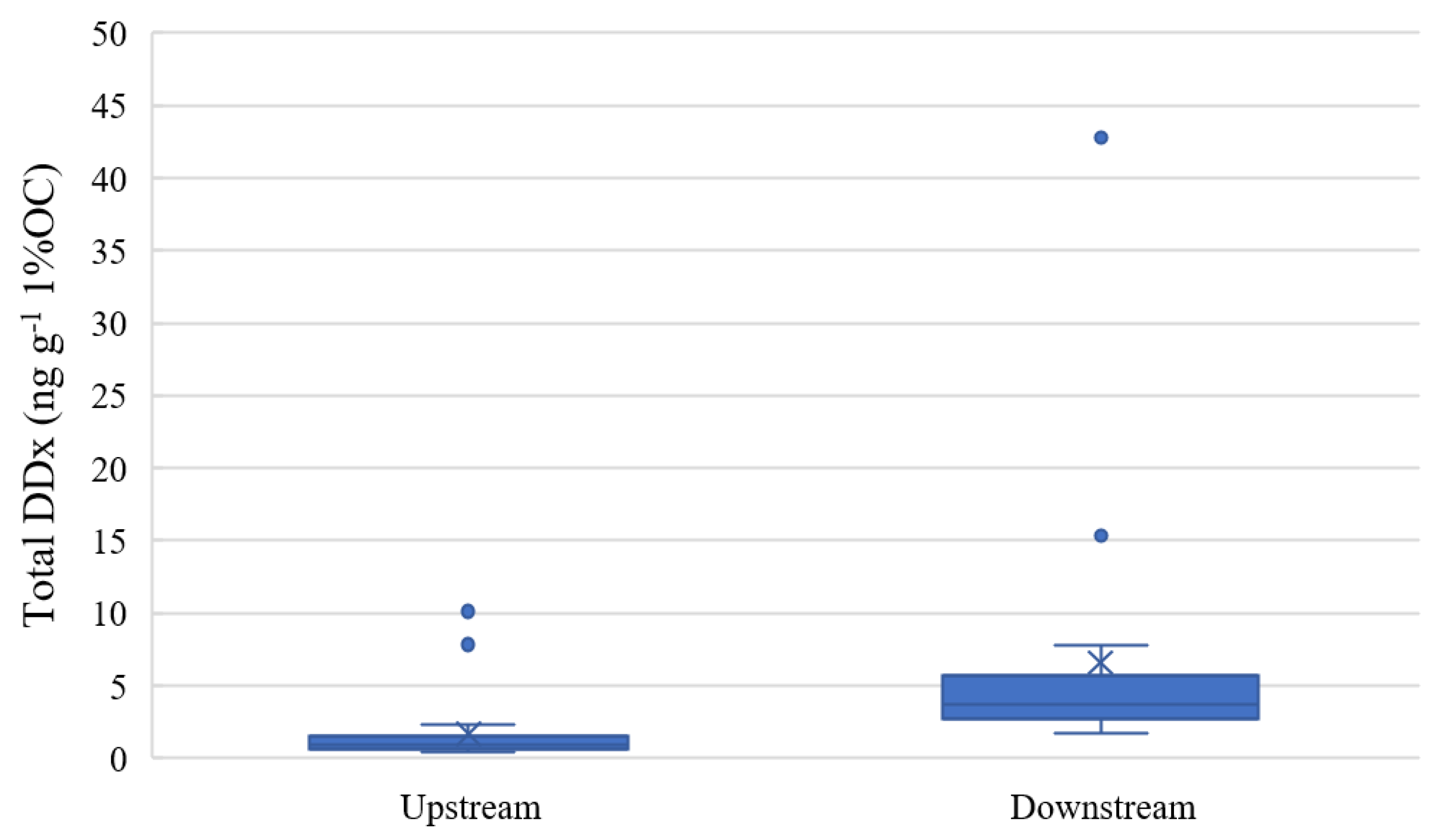
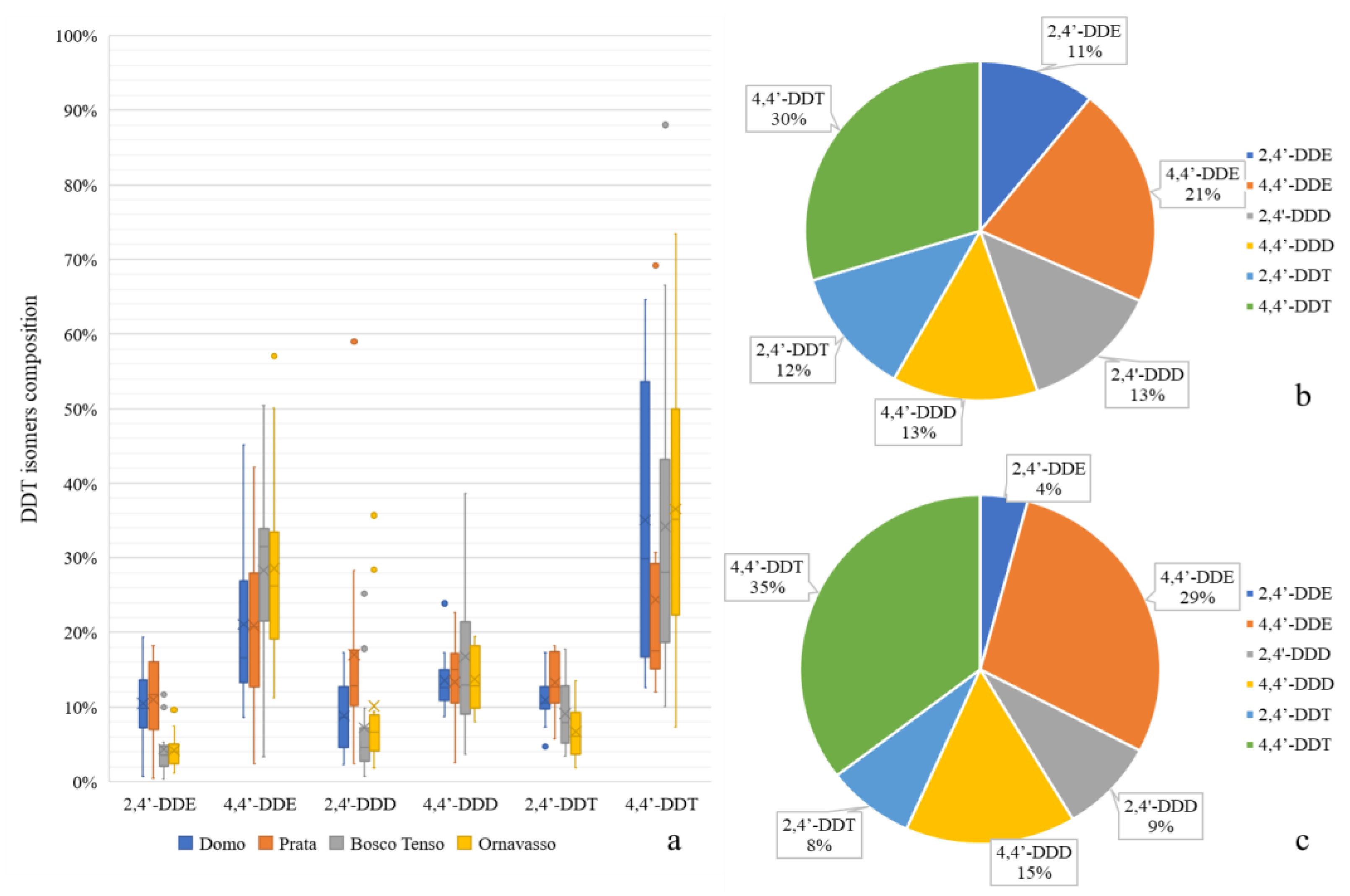
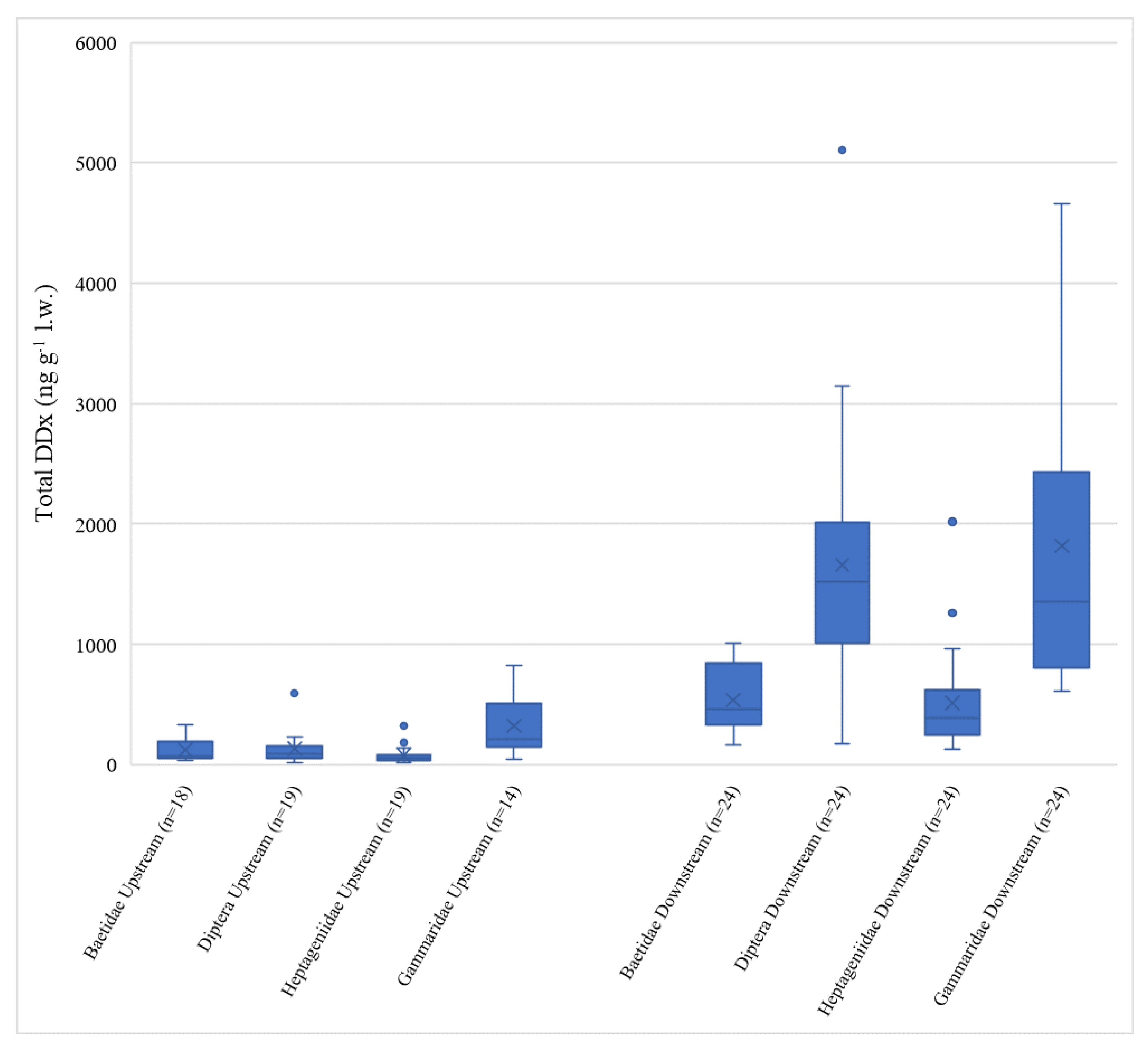

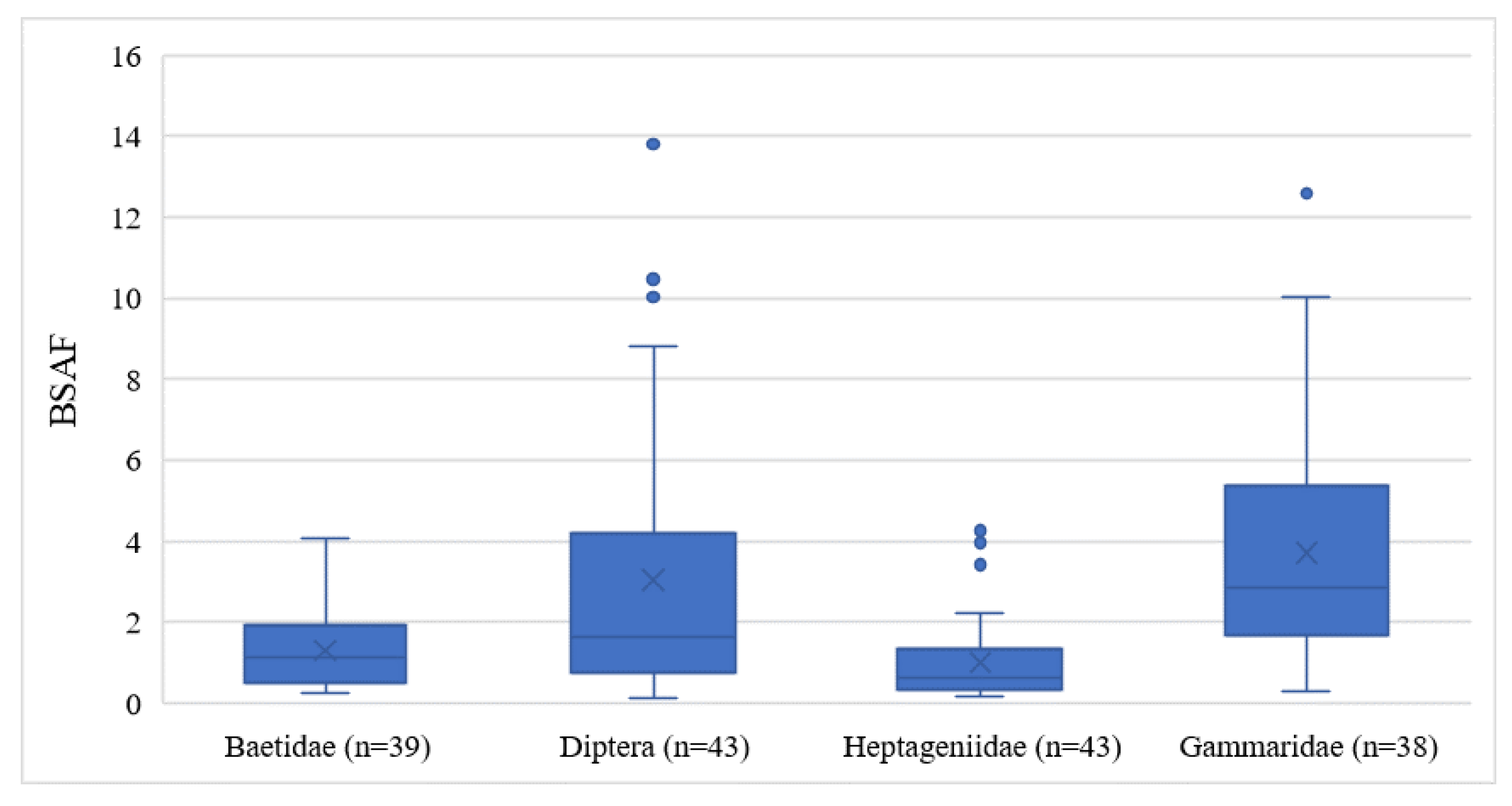
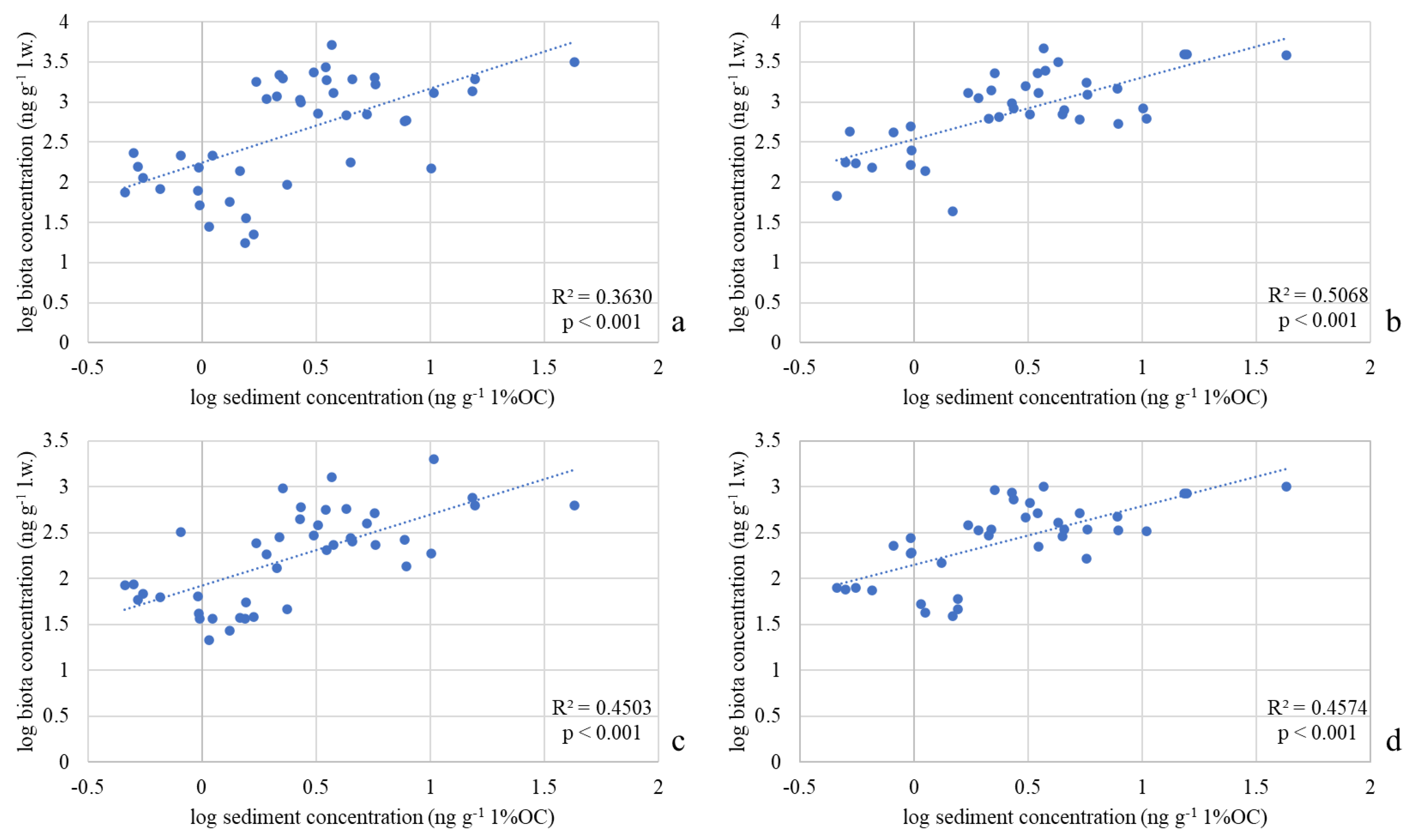
| Site | Geographic Coordinates Cartographic System UTM32 North, Datum WGS84 | |
|---|---|---|
| Domo | 444,550.113 | 5,102,819.384 |
| Prata | 444,321.655 | 5,097,959.092 |
| Bosco Tenso | 448,722.928 | 5,093,529.525 |
| Ornavasso | 455,086.026 | 5,091,518.449 |
| Location | DDx | References |
|---|---|---|
| Domo, Toce River (Italy) | 1.31 | This study |
| Prata, Toce River (Italy) | 3.36 | This study |
| Bosco Tenso, Toce River (Italy) | 13.96 | This study |
| Ornavasso, Toce River (Italy) | 8.28 | This study |
| Scheldt estuary (Belgium) | 0.03 | [40] |
| Congo River (Congo) | 0.12 | [41] |
| Tonghui River (China) | 1.1 | [42] |
| Ebro River (Spain) | 3.1 | [43] |
| Vaal River (South Africa) | 1.65 | [44] |
| Bahlui River (Romania) | 0.18–4 a | [45] |
| Cinca River (Spain) | 21.3 | [25] |
| Cinca River (Spain) | 93.9 | [25] |
| Qiantang River (China) | 95.8 | [46] |
| Bîc River (Moldova) | 25 | [9] |
| Rǎut River (Moldova) | 45 | [9] |
| Danube Delta (Ukraine) | 0.30–210 a | [47] |
Disclaimer/Publisher’s Note: The statements, opinions and data contained in all publications are solely those of the individual author(s) and contributor(s) and not of MDPI and/or the editor(s). MDPI and/or the editor(s) disclaim responsibility for any injury to people or property resulting from any ideas, methods, instructions or products referred to in the content. |
© 2023 by the authors. Licensee MDPI, Basel, Switzerland. This article is an open access article distributed under the terms and conditions of the Creative Commons Attribution (CC BY) license (https://creativecommons.org/licenses/by/4.0/).
Share and Cite
Tasselli, S.; Marziali, L.; Roscioli, C.; Guzzella, L. Legacy Dichlorodiphenyltrichloroethane (DDT) Pollution in a River Ecosystem: Sediment Contamination and Bioaccumulation in Benthic Invertebrates. Sustainability 2023, 15, 6493. https://doi.org/10.3390/su15086493
Tasselli S, Marziali L, Roscioli C, Guzzella L. Legacy Dichlorodiphenyltrichloroethane (DDT) Pollution in a River Ecosystem: Sediment Contamination and Bioaccumulation in Benthic Invertebrates. Sustainability. 2023; 15(8):6493. https://doi.org/10.3390/su15086493
Chicago/Turabian StyleTasselli, Stefano, Laura Marziali, Claudio Roscioli, and Licia Guzzella. 2023. "Legacy Dichlorodiphenyltrichloroethane (DDT) Pollution in a River Ecosystem: Sediment Contamination and Bioaccumulation in Benthic Invertebrates" Sustainability 15, no. 8: 6493. https://doi.org/10.3390/su15086493
APA StyleTasselli, S., Marziali, L., Roscioli, C., & Guzzella, L. (2023). Legacy Dichlorodiphenyltrichloroethane (DDT) Pollution in a River Ecosystem: Sediment Contamination and Bioaccumulation in Benthic Invertebrates. Sustainability, 15(8), 6493. https://doi.org/10.3390/su15086493







